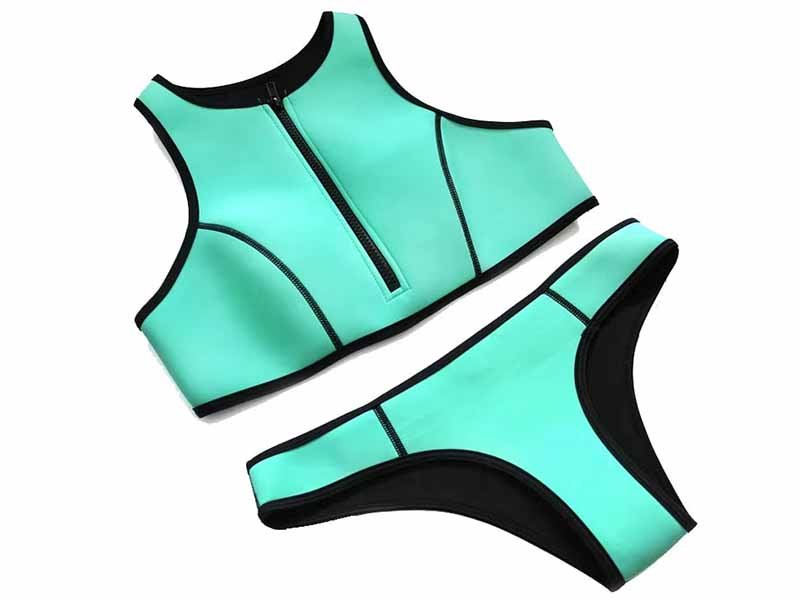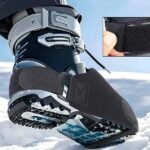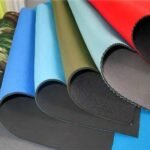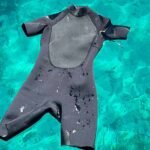When it comes to swimwear, most people think of nylon or spandex fabrics that are lightweight, stretchy, and designed for quick drying. But in recent years, neoprene bikinis have carved out a bold space in both fashion and sports. Made from the same material used in wetsuits, neoprene bikinis offer a structured fit, sculpted look, and unmatched durability—qualities that have made them a favorite among surfers, influencers, and luxury swimwear brands alike.
In simple terms, a neoprene bikini is a swimsuit made from neoprene—a synthetic rubber material known for its flexibility, insulation, and sleek finish. Unlike traditional bikinis, neoprene bikinis provide a body-sculpting effect, vibrant color blocking, and enhanced support, making them both functional and fashionable.
A neoprene bikini is a swimsuit made from neoprene, a synthetic rubber fabric best known for wetsuits. Unlike traditional swimwear fabrics like nylon or polyester, neoprene offers more structure, durability, and a sculpted fit. It is popular for surfing, water sports, and fashion-forward swimwear because it holds its shape, features bold color-blocking designs, and provides extra support. This makes neoprene bikinis both stylish and functional for active and leisure use.
Neoprene bikinis have become icons in summer wardrobes because they bridge performance and lifestyle. You’ll see them in glossy magazines, in Instagram campaigns, and on surfers catching waves in Australia or California. Their rise wasn’t accidental—it’s the result of a material originally designed for functionality crossing into the world of fashion. In fact, some of the earliest neoprene bikinis appeared when designers cut wetsuits into two-piece sets, testing whether utility could meet style. That spark led to an entirely new swimwear category.
As you read further, we’ll explore the key questions buyers often ask about neoprene bikinis: What makes them unique? Which styles are available? How do they perform in comfort and function? Do they need special care? And most importantly—how can you choose the right neoprene bikini for your needs? Let’s dive in.
What Is a Neoprene Bikini and How Is It Different from Traditional Swimwear?
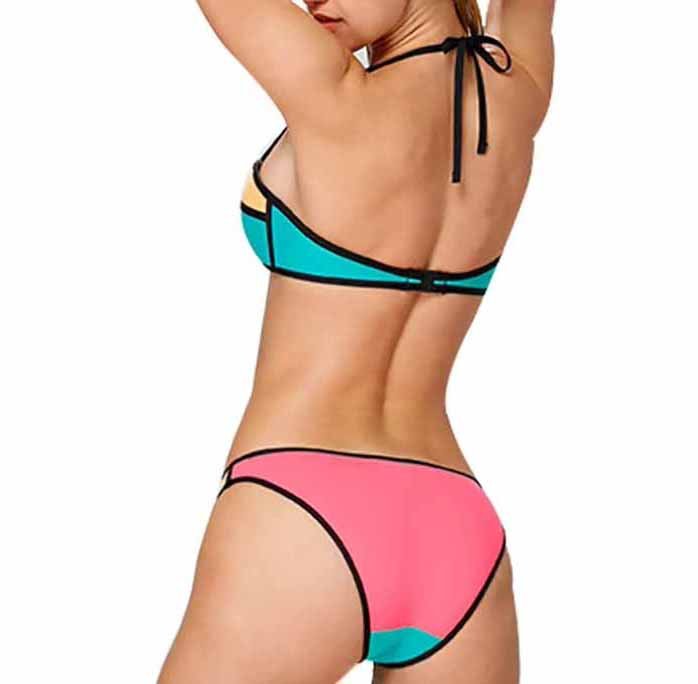
A neoprene bikini is a swimsuit made from neoprene, the same synthetic rubber used in wetsuits. Unlike nylon or spandex bikinis, neoprene bikinis are thicker, more structured, and provide a sculpted fit. They resist sagging when wet, hold bold shapes, and often feature striking color-blocking designs. Traditional bikinis prioritize lightweight comfort, while neoprene bikinis emphasize durability, body contouring, and sporty aesthetics, making them ideal for both fashion statements and water activities.
Neoprene was originally engineered for performance in diving and surfing wetsuits, where insulation, durability, and flexibility are crucial. When adapted to bikinis, these properties create a completely different experience compared to traditional swimwear fabrics.
- Structure vs. Flexibility: Standard bikinis made from nylon or polyester blends stretch easily, conforming closely to the body but often losing shape over time. Neoprene, being thicker, maintains its form. This creates a sculpted silhouette, which many consumers value for confidence and aesthetics.
- Durability and Resilience: Neoprene withstands harsher conditions like sun exposure, saltwater, and pool chemicals better than spandex-based fabrics. A nylon bikini might fade or loosen after a season, while neoprene often lasts longer.
- Design Possibilities: The thickness of neoprene allows for clean-cut edges and bold geometric designs. Many neoprene bikinis feature seamless edges or contrasting trims that wouldn’t hold in thinner fabrics.
Here’s a quick comparison:
| Feature | Neoprene Bikini | Traditional Bikini (Nylon/Spandex) |
|---|---|---|
| Material Thickness | 1.5–3 mm (structured) | 0.3–0.5 mm (lightweight) |
| Fit | Sculpted, body-contouring | Flexible, body-hugging |
| Durability | Long-lasting, resists sagging | Prone to fading/stretching |
| Design Aesthetic | Bold, sporty, high-fashion appeal | Versatile, casual, classic |
By bridging fashion and function, neoprene bikinis redefine what swimwear can offer, appealing to both performance-focused athletes and style-conscious buyers.
Why Are Neoprene Bikinis Popular in Fashion and Sports?
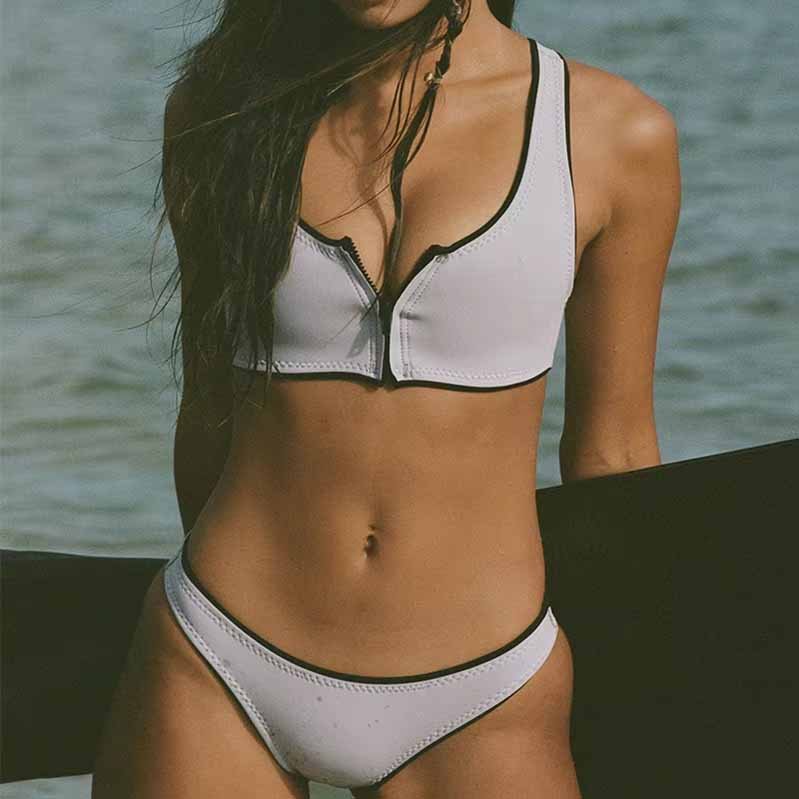
Neoprene bikinis are popular because they blend fashion and performance. Their structured design creates a sleek, sculpted look that appeals to fashion lovers, while the durable neoprene material withstands surfing, swimming, and beach sports. They’re known for bold color-blocking and a luxury feel, making them favorites for both athletes and influencers. This unique balance of style and function has turned neoprene bikinis into a staple in both activewear and high-fashion swim collections.
The rise of neoprene bikinis reflects how sportswear often crosses into mainstream fashion. What began as functional gear for surfers has become a high-fashion trend embraced by swimwear brands globally.
- Surf Culture Influence: Neoprene was already trusted in wetsuits for decades. When designers experimented with cutting wetsuits into bikini forms, surfers immediately recognized the functional appeal. A bikini that stays in place during active movements—like catching a wave—offered clear benefits.
- Runway to Beach: Fashion designers noticed neoprene’s bold finish and incorporated it into luxury collections. Color-blocking, neon piping, and architectural cuts made neoprene bikinis standout pieces in photo shoots and Instagram feeds.
- Durability & Longevity: For consumers tired of flimsy bikinis that sag after swimming, neoprene offered a solution. Its stiffness means it doesn’t cling uncomfortably when wet, and it maintains shape across seasons.
- Market Data: According to global swimwear market reports (Statista, 2024), performance swimwear segments are growing 5–6% annually, with neoprene products listed as “premium growth drivers.” The crossover appeal to both athletes and style buyers fuels this expansion.
- Celebrity & Influencer Endorsement: The likes of Gigi Hadid, Kendall Jenner, and surf influencers have all been spotted in neoprene bikinis, elevating them into aspirational fashion items.
In short, neoprene bikinis gained popularity because they meet the two biggest consumer demands in swimwear: lasting performance and distinctive fashion value.
Which Styles of Neoprene Bikinis Are Available?
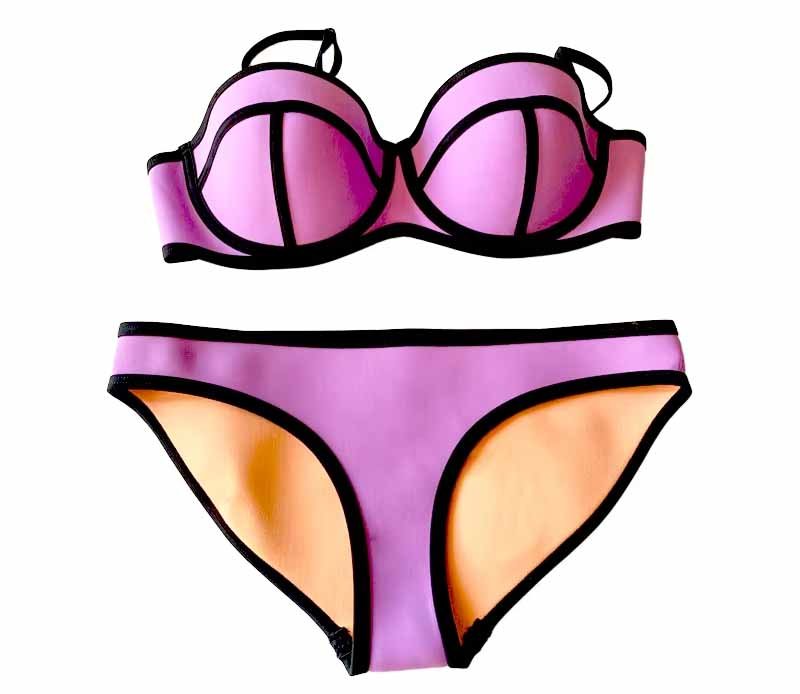
Neoprene bikinis come in many styles, including triangle tops, bandeau, high-waisted bottoms, sporty racerback designs, and surf-inspired cuts. Their thicker fabric allows for bold color-blocking and seamless edges, creating unique fashion looks. Popular styles combine functionality with statement aesthetics, ranging from minimalist monochrome designs to bright neon contrasts. This versatility makes neoprene bikinis appealing to both active water sports enthusiasts and fashion-conscious buyers who want a durable yet stylish swimwear option.
The beauty of neoprene as a material is its versatility. Designers have leveraged its structure and finish to produce a wide range of bikini styles that suit different body types, occasions, and consumer preferences.
- Triangle Tops & Classic Cuts: These are the closest to traditional bikinis but with a neoprene twist. The added thickness makes them hold shape better and prevents sagging when wet.
- Bandeau Tops: Often favored for fashion-forward buyers, bandeau neoprene bikinis stand out because they resist slipping compared to thinner fabrics, thanks to neoprene’s grip and stiffness.
- High-Waisted Bottoms: A retro-inspired design that neoprene elevates with body-contouring. They create a flattering hourglass silhouette and are popular among buyers who prioritize coverage with style.
- Sporty Racerback Tops: Designed with active water sports in mind, these cuts combine support with a sleek aesthetic. Surfers often prefer these for security during movement.
- Color-Blocked Sets: One of the most recognizable neoprene bikini trends, where contrasting neon or pastel panels are fused with clean-cut edges. This bold design became iconic in mid-2010s luxury swimwear collections.
| Style Type | Key Features | Best For |
|---|---|---|
| Triangle Top | Classic cut, sculpted by neoprene structure | Everyday beachwear |
| Bandeau | Strapless, non-slip grip, bold finish | Fashion photos, lounging |
| High-Waisted | Retro silhouette, body-contouring fit | Coverage with style |
| Racerback | Supportive, active-oriented design | Surfing, swimming, sports |
| Color-Blocked | Bright, geometric contrasts, seamless edges | Trendsetters, statement buyers |
By offering this wide variety, brands can cater to both the practical buyer (sports, active use) and the aesthetic-driven buyer (luxury, Instagram-worthy looks).
How Comfortable and Functional Are Neoprene Bikinis?

Neoprene bikinis are functional and comfortable for many wearers, offering structure, support, and a sculpted fit. However, compared to lightweight nylon bikinis, neoprene can feel thicker, warmer, and less flexible. This makes them excellent for water sports and surf-inspired looks but sometimes less breathable for prolonged sunbathing. Comfort often depends on the cut, thickness, and activity, meaning buyers should balance function and style when choosing neoprene swimwear.
Comfort and functionality are two of the most debated aspects of neoprene bikinis. Unlike traditional bikinis, which are feather-light and ultra-stretchy, neoprene introduces unique pros and cons.
- Support & Structure: Many wearers appreciate neoprene bikinis for their bra-like structure. The thicker material offers bust support and a secure fit, especially during movement, which is why surfers prefer them over flimsy alternatives.
- Thermal Properties: Because neoprene was originally designed to insulate divers, it retains warmth better than nylon. This is beneficial in cooler waters but may feel hot under direct sun for long lounging sessions.
- Flexibility Limits: Standard neoprene is less stretchy than Lycra blends, which can create some restriction. That said, many modern neoprene bikinis blend spandex or use thinner neoprene panels (1.5–2 mm) for greater comfort.
- Water Behavior: Neoprene bikinis hold their shape when wet and don’t sag, unlike nylon suits that sometimes feel heavy when soaked. However, they may take longer to dry.
- Activity Fit: For surfing, paddleboarding, or active beach games, neoprene is superior. For tanning or leisure wear, nylon might still win in comfort.
| Feature | Neoprene Bikini | Nylon/Spandex Bikini |
|---|---|---|
| Bust Support | Strong, sculpted fit | Light, minimal |
| Breathability | Moderate, retains heat | High, cooler to wear |
| Drying Time | Slower, thicker material | Fast-drying |
| Best For | Sports, water activities | Lounging, casual swim |
Ultimately, neoprene bikinis balance performance-driven comfort with fashion appeal, but buyers should match them to intended use.
Do Neoprene Bikinis Require Special Care and Maintenance?
Yes, neoprene bikinis require special care to maintain their shape and color. They should be rinsed with fresh water after use, hand-washed with mild soap, and air-dried away from direct sunlight. Avoid wringing, machine washing, or ironing, as neoprene is sensitive to heat and chemicals. With proper care, a neoprene bikini can last multiple seasons while retaining its structure and vibrant design, unlike traditional bikinis that may fade or stretch more quickly.
Neoprene bikinis demand more careful maintenance than standard swimwear, mainly due to the fabric’s thickness and sensitivity to heat.
- Rinsing: After exposure to saltwater or chlorine, immediate rinsing is crucial. Salt crystals can stiffen neoprene, and chlorine accelerates breakdown of synthetic rubber.
- Washing: Machine washing is strongly discouraged. Neoprene fibers can delaminate or lose elasticity under harsh cycles. Instead, use mild detergents or wetsuit shampoos and hand wash gently in cool water.
- Drying: Direct sun or dryers can cause neoprene to crack or warp. Best practice is air-drying in a shaded, ventilated space. Hanging should be avoided for tops, as weight can stretch them; lay flat instead.
- Storage: Neoprene should not be folded sharply, as creases may become permanent. Rolling or laying flat is ideal. Some brands even recommend special storage bags to prolong lifespan.
- Stain & Odor Management: If neoprene retains odor, a vinegar-water soak (diluted) can neutralize smells. For sunscreen stains, gentle spot cleaning works best.
In short, proper care ensures neoprene bikinis remain vibrant, structured, and long-lasting—protecting both investment and fashion value.
Are Neoprene Bikinis Suitable for All Body Types and Activities?
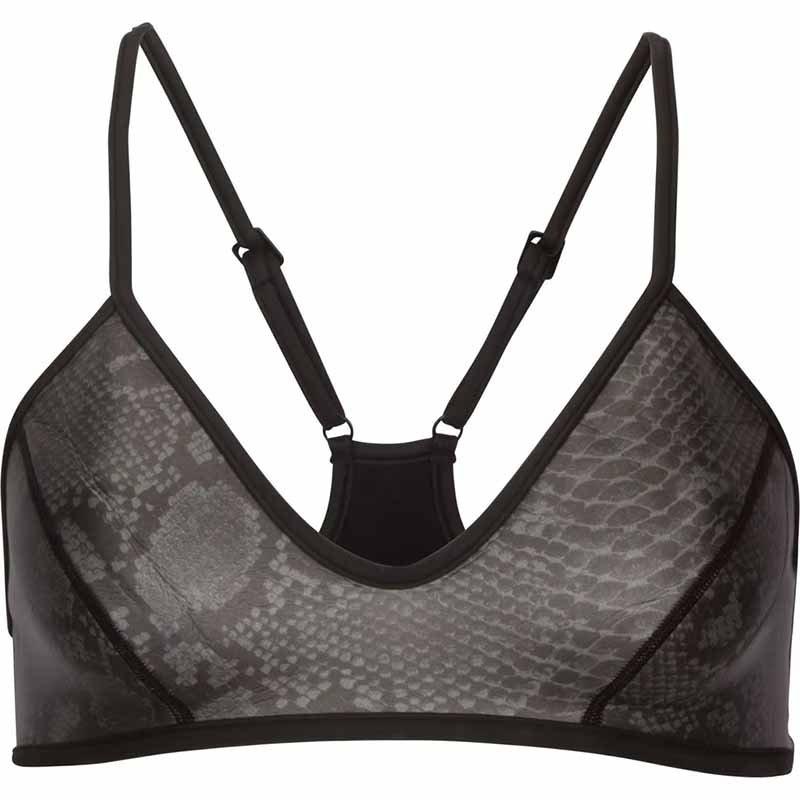
Neoprene bikinis suit many body types because their structured material enhances curves and provides support. High-waisted and racerback styles are especially flattering for fuller figures, while triangle and bandeau cuts cater to slimmer builds. However, neoprene’s limited stretch means buyers should focus on accurate sizing. For activities like surfing or paddleboarding, sporty cuts work best, while for lounging, lighter fabrics may feel more comfortable. Neoprene is versatile but not universally ideal for every body or activity.
One of neoprene bikinis’ greatest strengths is their ability to flatter various body types, but limitations also exist.
- Support for Curves: Women with fuller busts often struggle with flimsy bikinis. Neoprene’s thicker structure and sculpted cups provide lift and security, particularly in racerback or halter designs.
- Slim Frames: For those with smaller busts or slim builds, neoprene adds shape and contour. The structured lines give volume where traditional bikinis may appear flat.
- Athletic Builds: High-waisted bottoms paired with bandeau or racerback tops create balance, enhancing curves on straight or athletic frames.
- Limitations in Stretch: Because neoprene doesn’t stretch as much as spandex, it can feel restrictive if sizing isn’t precise. This makes trying on or checking size charts crucial.
- Activity Suitability:
- Surfing & Sports: Racerback tops and secure bottoms are ideal. Neoprene resists shifting, which prevents wardrobe malfunctions during active sports.
- Lounging & Tanning: Lighter fabrics may feel cooler and more breathable, though bandeau neoprene tops remain stylish for poolside wear.
| Body Type | Recommended Neoprene Styles |
|---|---|
| Fuller Bust | Racerback, halter tops, thicker bands |
| Slim Build | Triangle tops, color-blocked sets |
| Athletic/Rectangular | High-waisted bottoms, bandeau tops |
| Curvy Hips | Sporty cuts with structured waist |
In short, neoprene bikinis can flatter almost every figure—but the best results come from selecting the right style and size for your body and intended activity.
How to Choose the Right Neoprene Bikini for Your Needs?
To choose the right neoprene bikini, consider fit, thickness, and purpose. For water sports, opt for supportive racerback or sporty cuts; for fashion, select bold color-block or bandeau styles. Check thickness (1.5–2 mm for comfort, 3 mm for structure) and ensure accurate sizing since neoprene has limited stretch. Buyers should also factor in climate, care needs, and brand reputation. Ultimately, match style and function to your lifestyle for the best choice.
Selecting the ideal neoprene bikini involves more than picking a design you like—it’s about aligning functionality, style, and personal comfort.
- Fit & Sizing: Because neoprene doesn’t stretch much, precise sizing is critical. Buyers should refer to detailed size charts or even order a custom fit. Ill-fitting neoprene can feel restrictive.
- Thickness:
- 1.5–2 mm: More flexible, lightweight, and comfortable for warm climates or casual swimming.
- 3 mm: Offers stronger sculpting and durability, but retains more heat and is less breathable.
- Intended Use:
- Sports & Surfing: Racerback tops, supportive straps, and secure bottoms are essential.
- Fashion & Lounging: Bandeau or triangle tops with bold colors and trims make striking visual statements.
- Climate Considerations: In tropical climates, thinner neoprene is better to avoid overheating. In cooler waters, thicker neoprene helps retain warmth.
- Care Commitment: Buyers who want low-maintenance suits might prefer nylon alternatives. Neoprene requires hand-washing and careful drying.
- Brand Reputation: Some manufacturers cut corners with neoprene blends, leading to peeling or cracking. Choosing a trusted supplier ensures longevity.
| Selection Factor | Options & Recommendations |
|---|---|
| Thickness | 1.5–2 mm (comfort), 3 mm (support) |
| Activity | Sport (racerback), Fashion (bandeau) |
| Climate | Warm (thin neoprene), Cool (thicker) |
| Sizing | Must check carefully; limited stretch |
| Care | Hand-wash, air-dry, avoid sunlight |
By carefully weighing these elements, buyers can select a neoprene bikini that doesn’t just look good but also functions seamlessly in their lifestyle.
Conclusion
Neoprene bikinis have proven themselves more than just a passing swimwear trend. They represent the intersection of performance and style, offering structure, durability, and eye-catching aesthetics that traditional fabrics rarely achieve. From surfers needing secure, functional swimwear to fashion-forward buyers chasing bold looks, neoprene bikinis meet diverse expectations
Yet, it’s important to recognize that neoprene isn’t a universal solution. It comes with trade-offs—less stretch, more warmth, and special care requirements. Buyers must weigh these factors against personal needs, climate, and intended activities. When matched correctly, a neoprene bikini delivers a unique swimwear experience that is both empowering and enduring.
In today’s market, where consumers demand both individuality and reliability, neoprene bikinis stand out. Whether it’s a high-waisted retro cut, a bandeau for lounging, or a racerback for sports, the options are endless. And with global swimwear trends emphasizing premium, versatile fabrics, neoprene continues to grow as a premium category.
Partner with Szoneier for Custom Neoprene Solutions
If you’re a brand, retailer, or designer exploring neoprene bikinis—or any neoprene-based products—you need a manufacturing partner who understands both the technical side of the material and the aesthetic demands of modern consumers.
At Szoneier, we bring:
- 18+ years of experience in neoprene research, manufacturing, and product development
- A wide portfolio including neoprene bikinis, wetsuits, bags, koozies, gloves, and covers
- Customization & private label services, from fabric R&D to design, sampling, and bulk production
- Low MOQ, fast sampling, and short lead times tailored for overseas clients
- Certified quality assurance with 100% guaranteed standards
Whether you need a new swimwear line, a custom collection for your brand, or wholesale solutions, Szoneier is here to deliver premium neoprene products that stand out in the global market.
Get in touch today to bring your neoprene bikini ideas to life.

